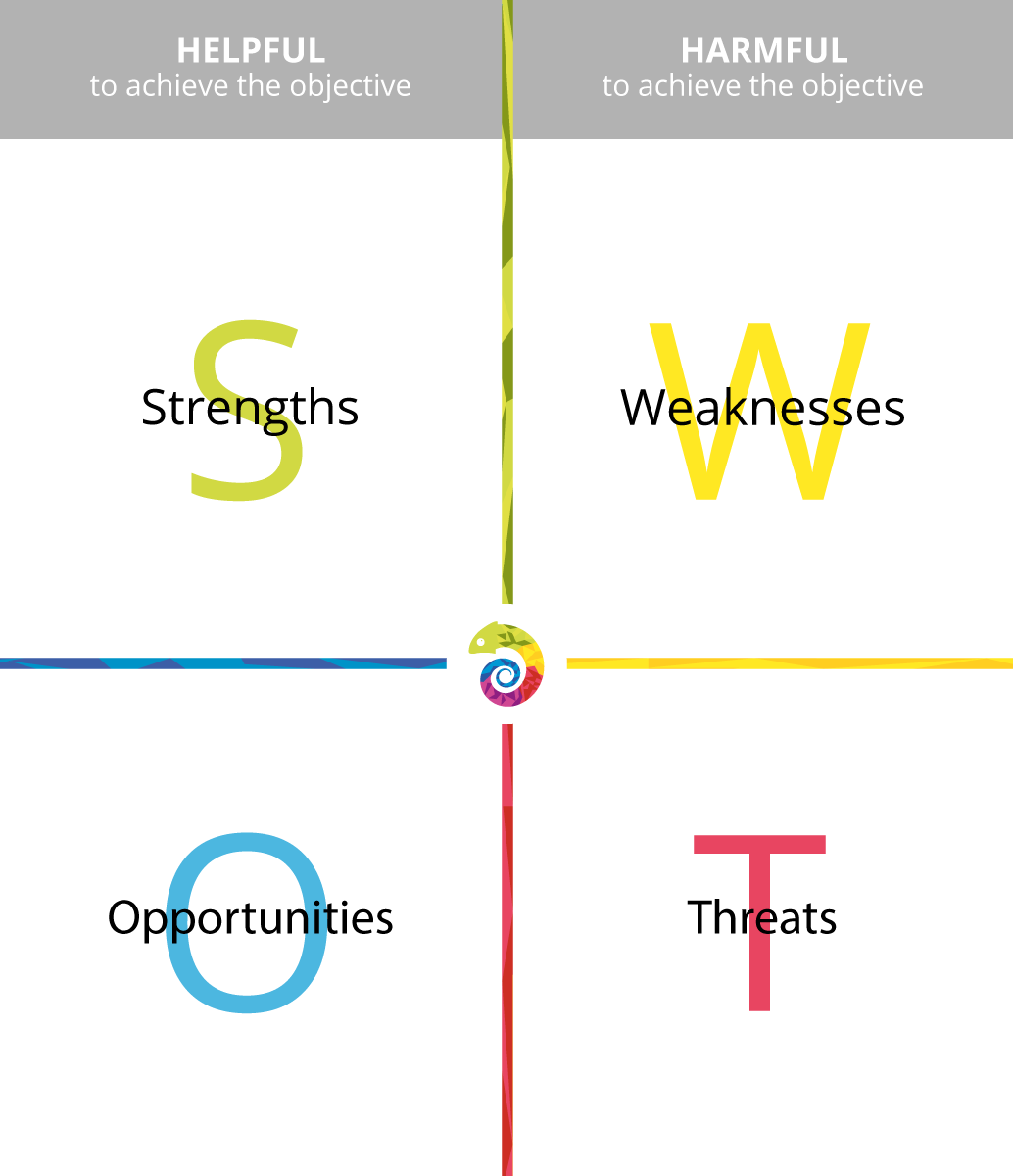Situational analysis, on the external environment and the internal capabilities of the organization, is essential to formulate the right strategic decisions that lead the company to achieve its goals.
How to do it? With the SWOT matrix.
If you are at the helm of a start-up or if you manage a consolidated business line, it is essential for you to identify Strengths, Weaknesses, Opportunities, and Threats (SWOT) for your business. The SWOT analysis can help you evaluate the attractiveness of a new market, but also only to analyze the feasibility of a project.
Whether you are a SWOT beginner or simply need an update, in this pill you will find a guide to compiling the SWOT Analysis and some practical advice on how to use it to the fullest to derive real benefits for your strategy.
Why make a SWOT
The situational analysis can be examined from two different perspectives: one external and one internal.
The analysis of the external environment considers the set of competitors that make up a business area and all the determining elements of the industrial structure.
Both the sector structure and the identified environmental macro-trends can have a positive impact (which we identify as an Opportunity), and a negative one (which we consider as a Threat) on the companies operating in that market sector.
The identification of opportunities and threats of the external environment helps to assess the attractiveness of the market for the company.
The internal environment instead refers to the values of the company, its objectives, and its organizational structure, to all its activities, resources and skills.
From the analysis of the internal environment, we can identify the Strengths and Weakness that represent the possible resources of the competitive advantage (or disadvantage) that could be created. The internal structure and dynamics of the company in fact influence its ability to reach and maintain a competitive advantage, which is a differential margin compared to competitors.
As we have seen, the external analysis allows us to assess the attractiveness of the market, while the internal one is the ability to reach and maintain a competitive advantage. We can, therefore, say that the situational analysis (of the external and internal environment) makes it possible to discover the sources of profitability and understand the possible performances (of the company business or of the project).
The SWOT analysis provides a summary view of the situational analysis. Useful in defining the strategy to explore a series of strategic alternatives or to review its decisions, the SWOT matrix is also an effective tool for exhibition and communication purposes.
The SWOT matrix
SWOT analysis matrix is a 2 × 2 table, whose four quadrants show a list of external opportunities and threats for your business (or project), as well as the strengths and weaknesses of the company with respect to its competitors. This matrix combines the two different perspectives: the external one, which requires you to consider the determinant of the sector and the trends evaluated from the point of view of the average competitor; and the internal one, which takes the point of view of your company and compares its distinctive characteristics with those of the competition.

How to populate the SWOT matrix
The list of opportunities, threats, strengths, and weaknesses are the result of brainstorming activities in which managers or experts evaluate the industry and the company based on their professional skills, usually without any model or line-specific guide to guide the process.
Although this approach is common because of its relative simplicity, it sometimes happens that key elements can be forgotten or underestimated even by experienced managers: each cell is powered by the application of structured strategy analysis models.
To populate the external analysis (opportunities-threats) you can start from the analysis of the five competitive forces (direct competitors, suppliers, customers, incoming potentials) and from the PEST analysis. For the internal analysis you can use Porter’s value chain model or a study on the resources of your company, in search of its main resources and skills.
ATTENTION TO THE PERSPECTIVE
In a “traditional approach” to SWOT, for external analysis, it is recommended to keep the perspective of an average player in the sector, while for internal analysis your company is considered compared to its competitors.
But the approach must always be critical and above all must take into account the level of market flexibility. It has often happened that the alleged strengths of large companies have then proved to be real weaknesses with respect to smaller and apparently weaker competitors. Small companies, on the other hand, often struggle to turn their weaknesses into advantages or to exploit the size and capabilities of larger competitors towards them.
In his article “Are Your Company’s Strengths Really Weaknesses?” published in Harvard Business Review, Adam Brandenburger, economist professor at Stern School of Business of New York, illustrates a “new approach” to SWOT.
This new approach recognizes that threats and opportunities can be both external and internal and that they can be shaped by your strengths and weaknesses, both ours and those of other players (large or small).
The compilation of the SWOT matrix is therefore anything but simple and requires a good capacity for analysis and strategic vision. A mind open to all possible scenarios.
How to use the SWOT matrix
In front of the summary view of the SWOT matrix, you can bring some wise questions that could reveal useful insights on the strategic alternatives you have at hand. Such as? Mixing and combining strengths and weaknesses with opportunities and threats. From this cross, you can understand for example what are the strengths you can use to take advantage of opportunities; or what are the strengths to use to defend yourself from threats. In the same way, you can understand which Weak Points allow you to take full advantage of an Opportunity, or perhaps if that is what amplifies the negative effect of a Threat.
But don’t forget also to bring those important questions Brandenburger calls, in his article, “upside-down”: which of your Strengths could turn out to be Threats facing apparent weaknesses of your competitors? What weaknesses could you instead take advantage of to counter competitors’ apparent strengths and be able to seize opportunities?
The SWOT analysis, therefore, allows you to formulate a series of possible strategic alternatives or decisions at the level of corporate strategy.
What you can obtain from a SWOT
If you apply the SWOT analysis to your company, by analyzing its specific business area you can get something similar to the following for example.
OPPORTUNITIES deriving from the external environment:
- new emerging markets
- increase in demand
THREATS deriving from the external environment:
- new restrictive regulations
- competition from emerging markets
- substitute products that could be an alternative to yours
STRENGTHS inside the company:
- brand awareness
- product quality
- customer loyalty
- distribution effectiveness
WEAKNESSES inside the company:
- limited geographical coverage
- small cash flow
- big turnover
- use of obsolete technology
Faced with a SWOT analysis of this type, a decision that you could take, for example, could be to launch new products on new markets.
Conclusion
The SWOT analysis can help you define clear and consistent goals. It allows you to learn more about the external competitive environment and an objective assessment of internal resources.
These elements will allow you to identify and build a sustainable competitive advantage in the market in which you operate.
We hope you have found this pill useful. If you have any doubts or want an opinion of our experts do not hesitate to contact us, we will be happy to help you!
See you at the next pill!




